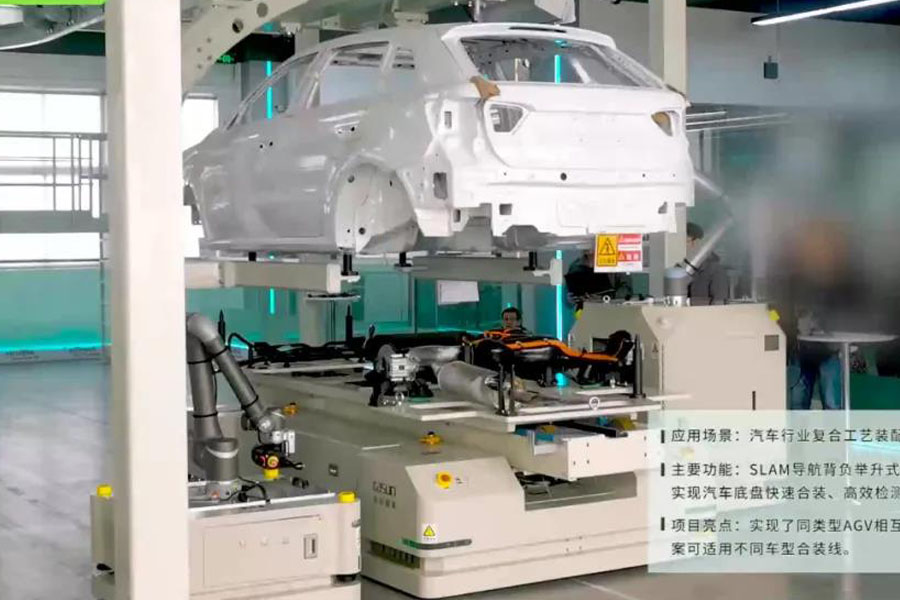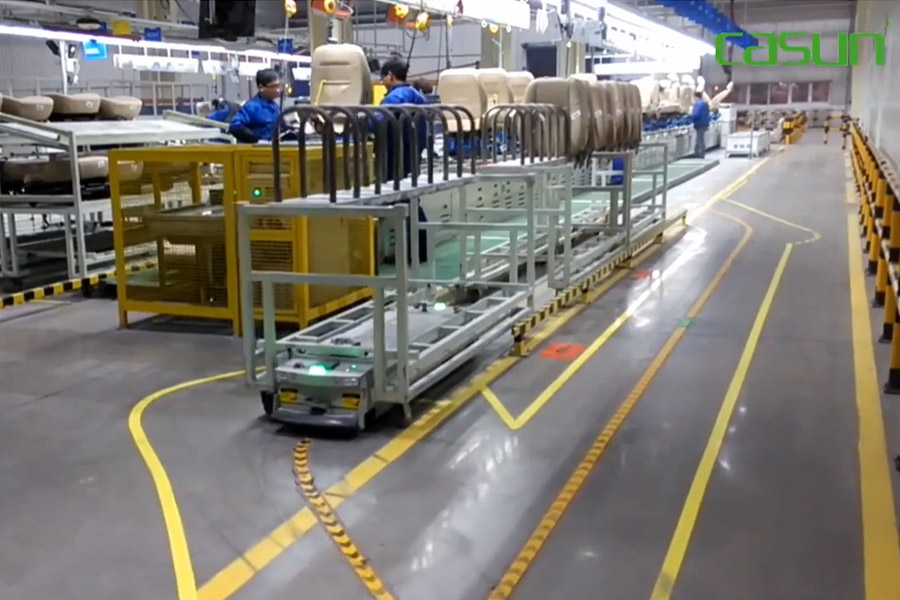The task of the automobile assembly shop is to assemble various parts, components and components such as engines and transmissions on the body base according to certain assembly technical requirements and assembly relationships to form a complete and qualified automobile. The main tasks completed in the assembly workshop include: storage and delivery of accessory parts, subassembly of various assemblies and parts and components, primary interior assembly of the body, chassis assembly, secondary interior assembly and various inspections of the entire vehicle , Refinishing paint and debugging work to ensure that the whole vehicle is qualified for storage.
Contents
- Automobile assembly workshop
- Intelligent planning direction of automobile assembly workshop
- Intelligent logistics upgrade for automobile final assembly
- The core of intelligent logistics upgrade for automobile final assembly
- Application of AGV in assembly shop
- AGV application scenarios
- Project application scenarios
Automobile assembly workshop
The automobile assembly workshop is the place where the painted body is turned into a finished car, and it is the workshop with the largest area in the whole car factory. Usually, a car has to assemble about 1000 to 2000 parts in the assembly shop. There are many types of parts and assembly processes. Therefore, the assembly shop is also the workshop with the most types of equipment.
General assembly process
The assembly process of the automobile final assembly process is: primary interior assembly → chassis assembly → secondary interior assembly → CP7 adjustment → four-wheel alignment test → speed test → exhaust gas analysis test → road test → rain test → vehicle inspection → storage.

Intelligent planning direction of automobile assembly workshop
At present, domestic and foreign automotive assembly process planning is developing towards automation, modularization, platformization, standardization, intelligence, digitization, and humanization. As far as possible, PLC devices are used for equipment control, and assembly supplies are modularized. The start and speed of the production line are networked with the production management system, and the equipment shutdown information is always connected with the production management.
Intelligent logistics upgrade for automobile final assembly
In order to meet the assembly requirements of the automobile assembly workshop, a large number of equipment and management systems are required. The equipment in the assembly workshop includes conveying equipment, logistics equipment and management systems, gluing equipment, boosting equipment, testing equipment, filling equipment, press-fitting equipment, electricity Equipment, etc.
Conveying equipment: PBS conveying equipment, interior decoration line conveying equipment, chassis line conveying equipment, final line conveying equipment, commercial line conveying equipment, rain line conveying equipment, chassis subassembly line conveying equipment, door line conveying equipment, resin conveying line , Tire conveyor line, seat line, etc.;
Logistics equipment and management system: AGV and its auxiliary equipment (offline charging wall, battery, and its charger, battery trolley, online charging cabinet, AGV management system), loading and unloading device (kit device), front and rear windshield lifting device, reduction Vibrator assembly cross-line transport device.
The automobile assembly workshop has long logistics routes and frequent material transfers. The use of AGV effectively improves the intelligence of the assembly workshop.
The core of intelligent logistics upgrade for automobile final assembly
New assembly workshop:
In the planning stage, it is necessary to carefully study and formulate smart manufacturing plans and implement them in the implementation project. Determine the priorities and trade-offs of smart manufacturing projects according to the actual needs of the company. Since smart manufacturing projects are carried out almost simultaneously, the biggest difficulty is There may be inadequate considerations in the process or equipment, the problem of unmatched and uncoordinated smart manufacturing units or smart equipment groups, and various unexpected difficulties during the debugging process, which affect the implementation effect and progress. This requires smart manufacturing planners. , Process engineers, information engineers, automation engineers, etc. must have a unified coordination in advance, formulate relevant technical specifications and technical requirements, and reflect them in the equipment specification technical task book, and strictly supervise the implementation.
Intelligent transformation of the assembly workshop that has been put into production:
For the intelligent transformation of the production workshop, the biggest difficulty in its implementation is how to avoid the impact of intelligent transformation on normal production. The transformation technical plan, transformation implementation plan, and plan to ensure normal production all require repeated discussions and deductions. The risk of transformation is minimized.
It is necessary to determine the urgency of the transformation project according to the intelligent manufacturing plan, and give priority to solving the outstanding problems encountered, so that the intelligent transformation can empower the manufactured automobile products and enhance the competitiveness of the products. To solve the problem of information system interconnection, product tracking, positioning and identification must be placed in the most prominent position, to solve the automatic identification and information transmission of vehicle models, and to better realize other intelligent manufacturing application scenarios.
In short, the realization of the intelligentization of the automobile manufacturing assembly workshop is the development direction of manufacturing technology. There are many application scenarios for the intelligentization of the assembly. The realization of intelligence can significantly improve the QCDI level of automobile manufacturing and enhance the market competitiveness of products. It requires relevant professional scientific and technical personnel. Only by teamwork and wisdom can we formulate a high-level intelligent plan for the assembly workshop.
Application of AGV in assembly shop
AGV application benefits
save human effort;
The application of AGV has changed the logistics and transportation mode, which can efficiently replace manual handling and reduce material distribution personnel;
reduce mistakes
The precise docking of the system reduces material supply problems caused by human error;
Increase productivity
Personnel work on hand to reduce labor intensity and improve production efficiency;
Reduce safety risks;
AGV replaces battery trucks, forklifts and other operating vehicles, greatly reducing the safety hazards caused by man-machine shuttle;
Increased intelligence
All processes are seamlessly connected through AGV to improve the intelligence of the factory;
Save space and improve space utilization;
The flexibility of AGV solves the problems of traditional transmission tools that occupy a large space and are difficult to transform. Logistic transportation mostly uses traction AGV, which is small in size and low in price. It is used in conjunction with a truck with casters to transport the truck to a designated location.
AGV application scenarios
AGV can be divided into many types according to different elements (such as navigation mode, load mode, etc.). AGV application angles and AGV functions are classified in the automobile assembly shop, and the AGV application scenarios in the assembly shop are listed. In the assembly workshop, there are mainly two types of assembly AGV and distribution AGV.
Assembly AGV
The assembly type AGV is mainly used for the assembly of the power assembly on the chassis line of the car, the rear suspension assembly with compression damping springs, and the body in white. According to the form of the lifting mechanism, it can be divided into single lift type and double lift type. type.
Application scenarios:
(1) The single-lift AGV is composed of an AGV body and a lift. It is mainly suitable for the assembly of the powertrain of the car and the body in white and is used for the assembly of the rear suspension assembly with compression damping springs and the body in white.
(2) The dual-lift AGV is composed of an AGV body and two lifts. It is mainly suitable for the assembly of the powertrain and the white body of the automobile, and the assembly of the rear suspension assembly with compression shock absorber springs and the white body.
Distribution AGV
The distribution type AGV is simple in structure, equipped with lifting pins, and has the functions of distribution, automatic uncoupling and hooking of the same material car. According to the driving mode, the distribution type AGV can be divided into one-way drive type and two-way drive type.
Application scenarios:
(1) The one-way drive AGV can only move forward in a single direction, and the running route is a closed loop. Multiple AGVs can run simultaneously in a sequence. It is suitable for the distribution of line materials with strong rhythm, the same as SPS (SetPartsSupply) The Shunjian mode is the best choice for the application.
(2) The two-way drive AGV can travel in both forward and backward directions. The running route is a single round-trip line. Only one AGV is allowed to run alone on the running route. It is suitable for material transportation between two points, and the AGV goes back and forth between two points. In operation, the material tooling is fixed with the AGV, and only loading and unloading materials is the best choice.
Project application scenarios
Application case: Powertrain assembly workshop
Solution Product: C3 Backpack Transfer Series
Function Description:
1. Connect different process lines to improve work efficiency;
2. Connect the entire process to make the process more smooth;
3. The rollers are automatically docked, and the docking accuracy is guaranteed;
